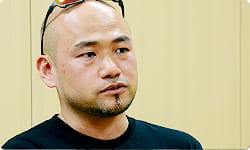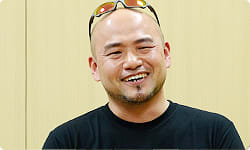Games Hold the Answer
It sounds like you played a lot of arcade games too.
I did. Thanks to trips to the arcade near the preparatory school, I have an especially deep and real experience with the golden age of 1980s arcade games. Back then, we would get excited every time they got a new system board and cabinet. We'd be like, "Whoa! It's here!"
In those days, when people who were into video games heard about a new game in the next town, they were so passionate that they would travel a good distance to play it.
On the topic of my junior high days, the arcade in front of the station was an off-school district, so there was a school regulation against kids going on their own. If you wanted to play video games, the only place was a small corner at a batting center near school, but it cost 100 yen per play, whereas it was only 50 yen at the arcade.
That's a big difference! (laughs) Did you wonder whether you should obey school rules and pay 100 yen or take a risk to pay only 50?
Yeah. At first, everyone went to the batting center. But in my second year of junior high, a transfer student named Machida-kun came. Macchi (Machida-kun's nickname) came from the city and was a little sophisticated.
Oh.
And just at that time, I heard that the batting center got Dragon Buster.17 My friends and I made plans to go play it on Saturday. I asked Macchi if he would like to come too, and—like it was nothing special—he responded, "The batting center's expensive, so let's go to the arcade." That really created a stir. 17. Dragon Buster: An action arcade game released by Namco Limited (now Namco Bandai Games Inc.) in January 1985. The NES version appeared in January 1987.
(laughs)
At the time, arcades seemed like places where troublemakers hung out. That's why everyone was shocked, but we were also intrigued by that air of badness. So we asked Macchi to take us to the arcade he'd been going to.
Oh, he had his familiar arcade in your town? It's more like the transfer student was you! (laughs)
He must have been going fairly often since he arrived. I was nervous and went to the arcade where Macchi usually went. I wasn’t sure which game to play as we watched attract mode.18 They may have only cost 50 yen, but my allowance was precious, so I watched others play, ran simulations in my head, and gave it careful consideration so I wouldn’t regret spending the money. 18. Attract mode: Images of gameplay that show while no one is actually playing the game.
That's fun, too.
Yes. But while I was hesitating over which game to play, it got dark outside and someone started saying we should leave. I still hadn't done anything but look, though, so I asked them to wait while I played something.
Uh-huh.
What I played first was Road Fighter19, which had the easiest rules to understand. That was the first coin I used at the arcade. I played that once and went home, but after that, every Saturday was video arcade day. 19. Road Fighter: A racing game developed by Konami Corporation that appeared in arcades in 1984. The courses are displayed from an overhead point of view as players control cars that race along fast-scrolling roads and avoid opponent vehicles and obstacles in an effort to reach the goal before running out of fuel.
You had loosened up and learned the thrill of video arcades.
Well, I didn't study, so as might be expected, I failed my high school entrance exam. But that one year at prep school was intense, and it continued into my high school life.
I see. But playing video games as a part of your life like that became a valuable asset.
Yes. For example, when displaying the items you've collected, instead of just showing a list of their names, it's much more exciting to see graphics of the items themselves, like in The Tower of Druaga.20 Without even realizing it, I learned from the simple arcades of yesteryear that kind of instinctive comprehensibility and aesthetics. 20. The Tower of Druaga: An action arcade game released by Namco Limited (now Namco Bandai Games Inc.) in July 1984. The NES version appeared in August 1985. Satisfying certain conditions and solving puzzles, player characters collect items hidden on each floor of a 60-story tower with the ultimate goal of rescuing a maiden imprisoned on the top floor. Xevious creator Masanobu Endo worked on the game design.
I think it's surprisingly difficult to notice such things simply by playing the games. But once you understand them and keep that information organized inside, then you can retrieve it right away, the way you just did. How did you come to have that perspective?
Hmm. I don't think I've changed.
So you always had that knowledge at your disposal?
No, I'm not even sure I do now. For example, when making Viewtiful Joe21, I made the map myself, and at first I couldn't make anything fun at all. 21. Viewtiful Joe: A side-scrolling action game released by Capcom for the Nintendo GameCube system in June 2003. It was characterized by deformed, American comics-style graphics and "VFX Action," which involved actions that manipulated space and time. It became the first in a series of games and was turned into a television anime series.
Viewtiful Joe was a completely new kind of action game made for the Nintendo GameCube.
Yes. I began developing that title when my boss at Capcom, Shinji Mikami-san22, said, “Try doing the design process by yourself.” Before that, I had been involved with big teams making games like Resident Evil 223 and Devil May Cry24, so it was my first time to come up with the project myself and see every last bit of it made.
22. Shinji Mikami: Former Department Manager, Development Department 4 at Capcom. He served as director or producer of the Resident Evil series up through the fourth installment. At present, he is executive producer at Tango Gameworks.
23. Resident Evil 2: A horror-action-adventure game released by Capcom in January 1998.
24. Devil May Cry: An action game released by Capcom in August 2001. Considered stylish and hard action, it developed elegantly and speedily, and attracted attention for the flashy, free-flowing way it portrayed defeating enemies. It became the first in a series.
That was when you first experienced making something from scratch.
I had checked maps made by others, but it was my first time to make one myself.
I would guess that a big reason for that was Mikami-san's desire to help you grow.
I suppose so. Mikami-san had also lived through the 8-bit NES era, so I think he wanted to give me the experience of starting up a project with relatively few people.
Uh-huh.
But I operated on instinct more than logic, so when I made a map myself, all sorts of problems would arise later on. For example, at the start, I would make a platform for jumping, but in the end, you could just walk along the ground without even using it.
I see.
It simply wasn't fun, so I placed an item called V-film25 in the air to have players jump. Then, when I lined up V-film along the parabola of a jump, I suddenly realized—after the fact—how that was just like coins in Super Mario! 25. V-film: An item that serves as the source of the VFX Powers that are crucial to making progress in the game.
Oh, really? So while the experiences themselves remain unorganized in your head, as you're working through a process of trial and error, you find hints in your old experiences and compare them?
Yes. When I make something, I don’t organize my thoughts at the beginning, like “That one game was like such-and-such, so I’ll do this.” Instead, it’s more like I suddenly notice something in the moment, like “Oh! So that’s why they made that game like that!” That was when I first realized I’d been doing just what you wanted me to do.
Right! (laughs)
Thus, I realized during development of Viewtiful Joe that the games I had played held important answers. And ever since, I have been much more conscious of the structure of gameplay.



